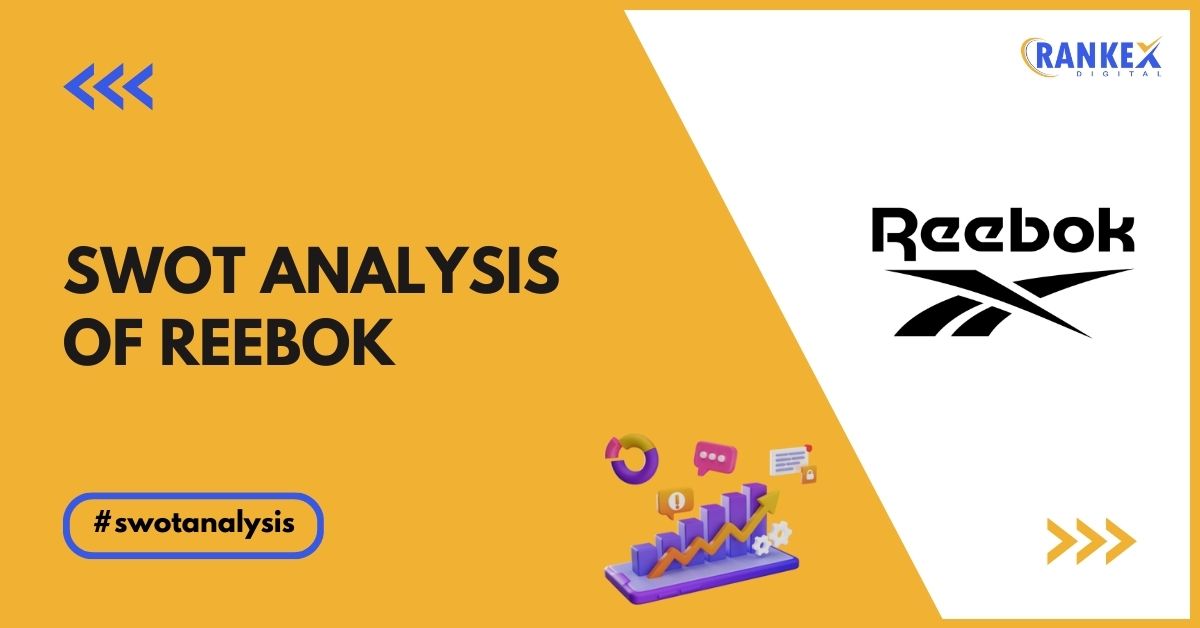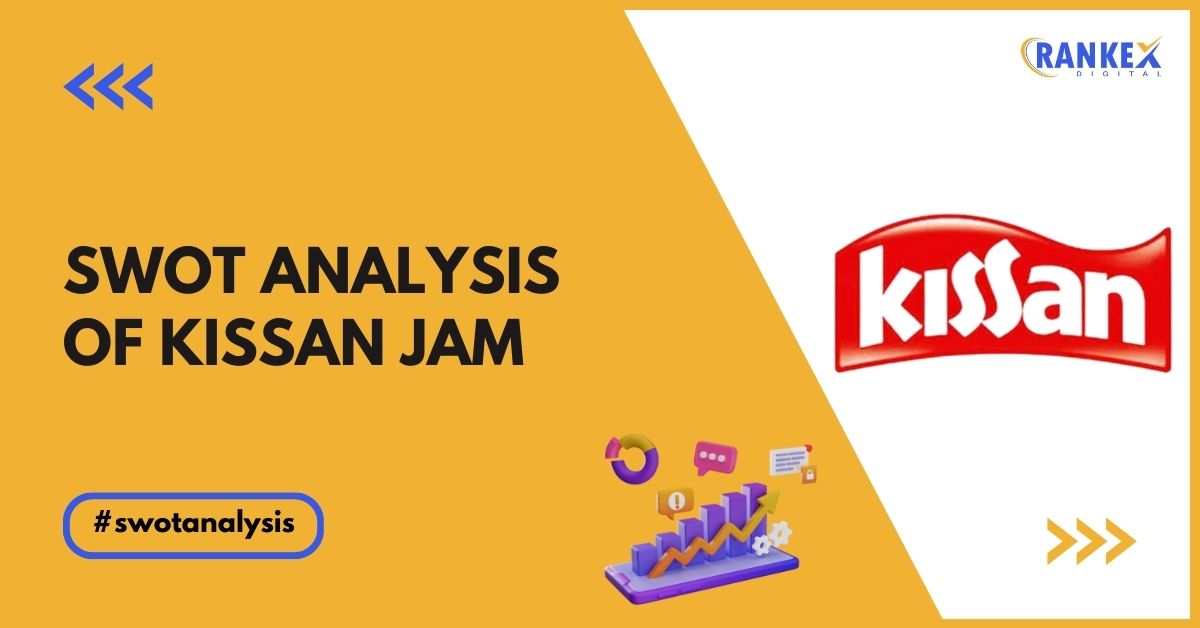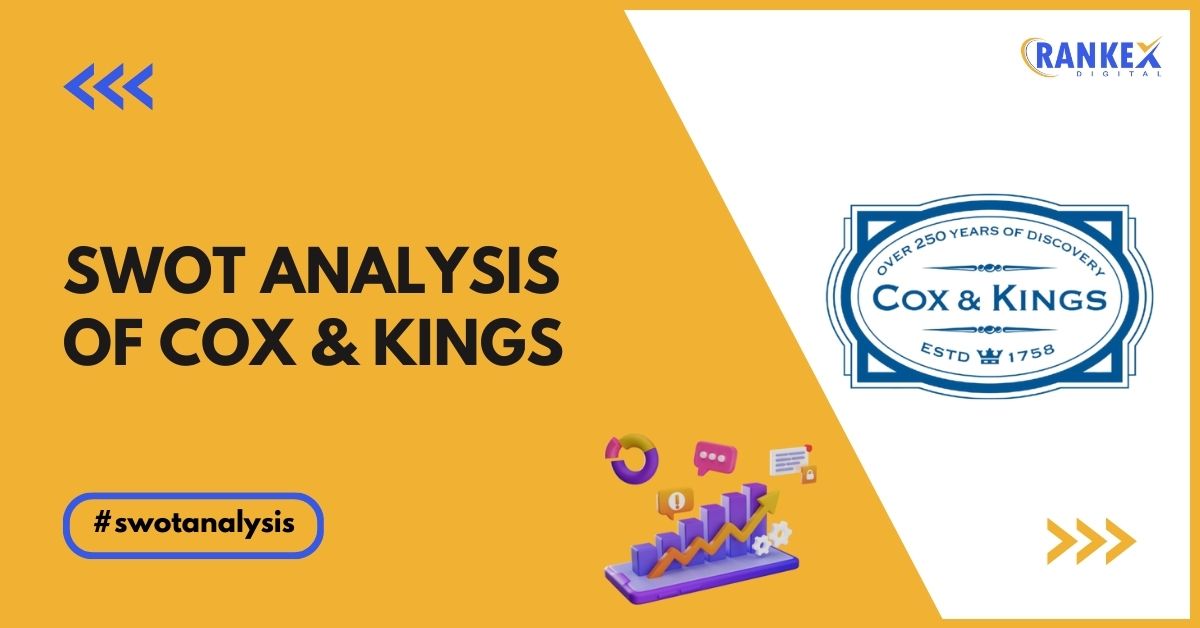Ben & Jerry’s, a beloved name in the ice cream industry, has earned its reputation for delivering premium-quality ice creams infused with bold flavours, unique chunks, and socially conscious values. Known for its quirky branding and commitment to sustainability, the company has carved a niche in the competitive frozen dessert market.
Conducting a SWOT analysis of Ben & Jerry’s is essential to understand its current position in the market and explore potential strategies for growth. Let’s dive into the strengths, weaknesses, opportunities, and threats faced by this iconic brand.
Table of Contents
Overview of Ben & Jerry’s
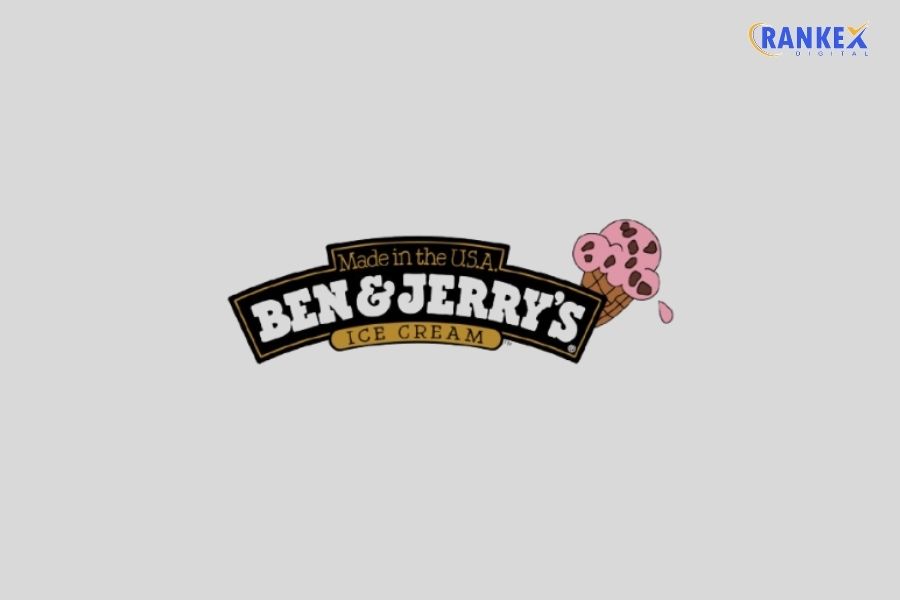
Founded in 1978 by Ben Cohen and Jerry Greenfield, Ben & Jerry’s began as a humble ice cream shop in Burlington, Vermont. Today, it is a global leader in the premium ice cream market, celebrated for its quirky flavours, such as “Chunky Monkey” and “Phish Food,” and innovative marketing strategies. Beyond its delectable offerings, Ben & Jerry’s is renowned for its commitment to social and environmental causes, championing sustainability, fair trade, and social justice.
Operating as a subsidiary of Unilever, the brand benefits from extensive resources and a vast distribution network. With a presence in over 35 countries, it continues to delight customers worldwide while staying true to its original mission of combining high-quality ice cream with a dedication to making the world a better place. This unique blend of creativity, ethics, and quality has solidified Ben & Jerry’s
Quick Stats About Ben & Jerry’s
| Founder | Ben Cohen and Jerry Greenfield |
|---|---|
| Year Founded | 1978 |
| Headquarters | Burlington, Vermont, USA |
| Parent Company | Unilever |
| Number of Flavors | 60+ |
| Revenue (2023) | Estimated $1.5 Billion |
SWOT Analysis of Ben & Jerry’s
Ben & Jerry’s, a premium ice cream brand known for its innovative flavours and commitment to social responsibility, has maintained a strong position in the global market. Below is an expanded analysis of the company’s Strengths, Weaknesses, Opportunities, and Threats.
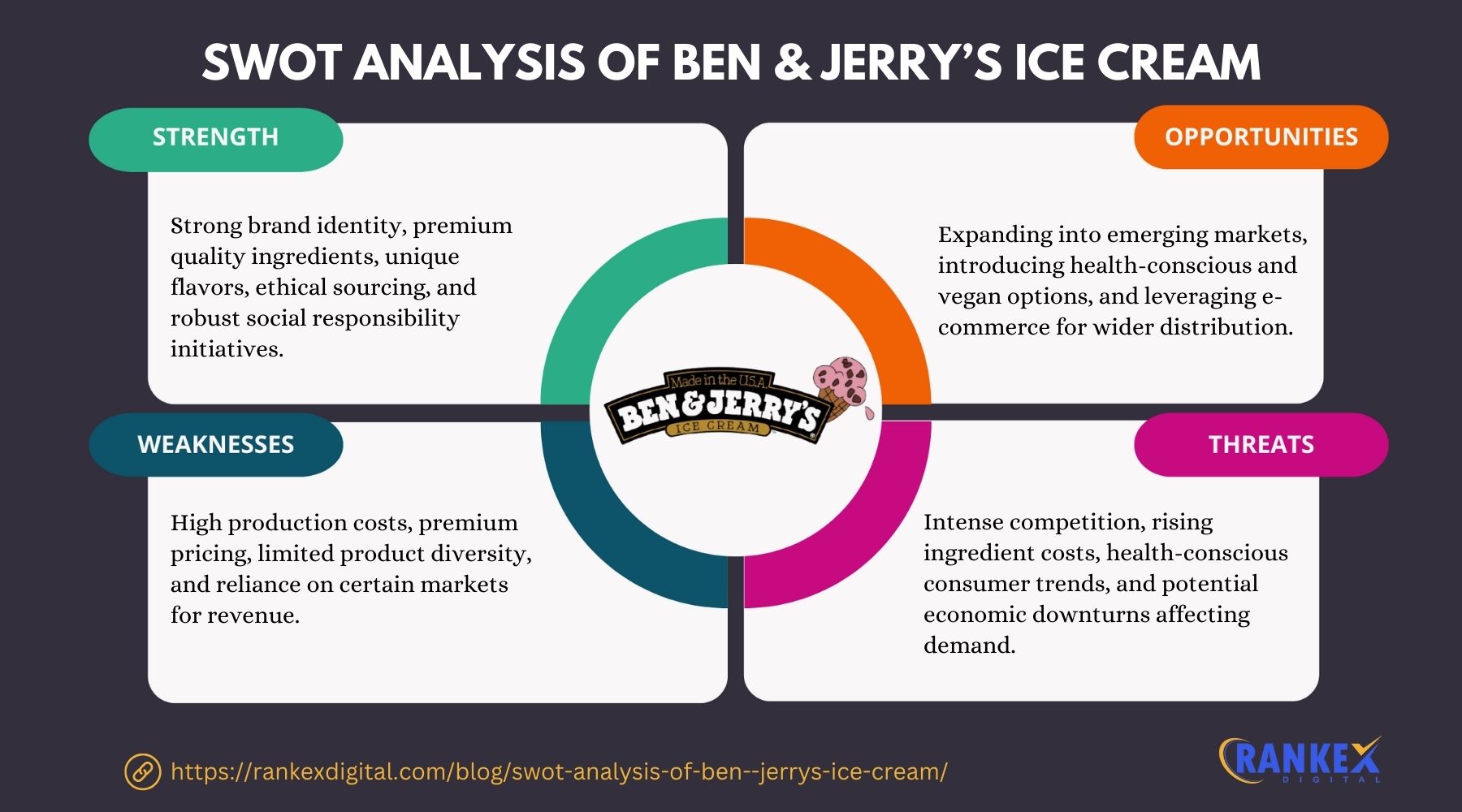
Strengths of Ben & Jerry’s:
- Strong Brand Identity:
Ben & Jerry’s has successfully built a unique, recognizable brand that resonates with consumers worldwide. Its quirky flavour names, colourful packaging, and commitment to social and environmental causes help it stand out in the competitive ice cream market. The brand is associated with being fun, innovative, and ethically responsible, creating an emotional connection with its customers, particularly among millennials and Gen Z. - Innovative Product Offerings:
The company is known for creating bold, imaginative flavours that go beyond traditional offerings. From “Chunky Monkey” to “Half Baked” and “Peanut Butter Cup,” Ben & Jerry’s continues to introduce new, exciting products that attract adventurous ice cream lovers. Their ability to regularly launch limited-edition flavours or collaborations with celebrities and pop culture brands keeps consumers engaged and excited. - Sustainability and Social Responsibility:
Ben & Jerry’s has long been at the forefront of corporate social responsibility. Its commitment to sustainability is evident in its sourcing practices—such as using Fairtrade-certified ingredients—and its efforts to reduce its carbon footprint. The company also supports various social causes, including racial justice, LGBTQ+ rights, climate change activism, and environmental protection. This approach strengthens its brand appeal among socially conscious consumers. - Loyal Customer Base:
The combination of high-quality ingredients and the brand’s alignment with social and environmental causes has fostered strong customer loyalty. Many Ben & Jerry’s customers are not just buying ice cream; they are supporting a brand that reflects their values. This loyalty is particularly strong in markets like the U.S. and Western Europe. - Strategic Partnerships:
Ben & Jerry’s has benefited from strategic partnerships, notably with its parent company, Unilever, which provides global distribution and resources. These partnerships allow Ben & Jerry’s to reach more customers, especially in international markets, while still maintaining its independent, activist brand identity. Additionally, its collaborations with celebrities (such as the “Phish Food” flavour with the band Phish) and other brands help amplify its visibility.
Weaknesses of Ben & Jerry’s:
- Premium Pricing:
One of the most significant challenges for Ben & Jerry’s is its premium pricing. The brand is positioned as a high-end ice cream, which can be prohibitive for price-sensitive consumers. In a competitive market, especially during economic downturns or in price-sensitive regions, this pricing strategy could limit Ben & Jerry’s market share. - Dependence on a Niche Market:
Although Ben & Jerry’s has a broad appeal, it predominantly attracts consumers who prioritize ethical consumption, social activism, and sustainability. This focus on a niche market might limit its ability to expand beyond certain demographics, particularly in regions where such values may not be as prevalent. The brand may struggle to penetrate more price-sensitive or conservative markets, where its ethical stance may not resonate as strongly. - Limited Product Range:
Ben & Jerry’s has been somewhat restricted in terms of product diversification. While the company has focused heavily on ice cream, it lacks the variety seen in other food categories like yoghurt, sorbet, or snacks. This narrow focus may limit its ability to compete with brands that offer a wider range of frozen or dairy-based products. - High Calorie and Sugar Content:
Many of Ben & Jerry’s ice cream products are considered indulgent, with high sugar and fat content. In an era where consumers are becoming increasingly health-conscious and more focused on low-calorie, low-sugar, or plant-based diets, this could become a barrier. As more consumers opt for healthier alternatives, the brand might face challenges in catering to this growing segment. - Vulnerability to Market Saturation:
The ice cream market, especially in Western countries, is highly saturated, with numerous competitors vying for consumer attention. Larger global brands like Häagen-Dazs, Nestlé, and local artisanal producers are all competing for market share. Ben & Jerry’s, despite its strong brand, risks losing ground in markets where consumers are seeking new and innovative products or where competitors replicate its ethical messaging.
Opportunities for Ben & Jerry’s:
- Expansion into New Markets:
Ben & Jerry’s has significant potential to expand further in emerging markets, where demand for premium products is growing rapidly. Markets in Asia, Latin America, and parts of Africa present opportunities for the brand to establish itself, particularly among urban, middle-class consumers who are more willing to spend on luxury products. In these regions, Ben & Jerry’s could leverage its ethical and socially responsible image to differentiate itself from competitors. - Healthier Product Innovations:
The demand for healthier food options is growing, and Ben & Jerry’s can capitalize on this trend by introducing more low-calorie, low-sugar, and plant-based ice cream alternatives. The rise of veganism and lactose intolerance concerns has made the plant-based food market especially promising. By developing new products in this category (e.g., vegan ice creams or lower-sugar variants), Ben & Jerry’s can tap into a broader consumer base and align itself with the growing health-conscious demographic. - Increased Demand for Ethical and Sustainable Products:
As consumer preferences shift toward sustainability, companies that emphasize ethical practices can gain a competitive edge. Ben & Jerry’s is already well-positioned in this space, and it can expand its efforts by further promoting its environmental and social initiatives. This may include increasing transparency in its supply chains, expanding its fair-trade certifications, or introducing new environmentally-friendly packaging solutions. - Collaborations and Limited Edition Flavors:
Ben & Jerry’s could continue to expand its partnerships with other brands, celebrities, and artists to create new flavours or special-edition products. These collaborations often generate buzz and can help the company reach new audiences. For instance, working with popular food brands, musicians, or even activist organizations can boost its appeal among fans of these collaborators. - Online and Delivery Growth:
The rise of e-commerce and food delivery services presents a valuable opportunity for Ben & Jerry’s. By enhancing its online presence and partnering with delivery platforms like Uber Eats, Grubhub, or DoorDash, Ben & Jerry’s can make its products more accessible to consumers who prefer to shop online or have food delivered. Direct-to-consumer online sales could also be a way to enhance customer loyalty and increase profits.
Threats to Ben & Jerry’s:
- Intense Competition:
The global ice cream market is fiercely competitive, with major players like Häagen-Dazs, Nestlé, and private label brands often offering similar products at lower prices. Smaller, boutique ice cream brands are also rising in popularity, especially those that focus on organic, artisanal, or innovative flavours. This intense competition could erode Ben & Jerry’s market share, particularly in areas where price is a key consideration for consumers. - Fluctuating Raw Material Costs:
Ben & Jerry’s relies on premium ingredients, including milk, sugar, and cocoa, which can be subject to price volatility. Factors such as climate change, supply chain disruptions, or geopolitical instability can cause the prices of these raw materials to rise, potentially squeezing profit margins and forcing the company to raise prices, which could impact demand. - Health and Wellness Trends:
The growing shift towards healthier diets and reduced consumption of sugary, fatty foods poses a threat to Ben & Jerry’s, as many of its products are indulgent and calorie-dense. As more consumers turn to plant-based, dairy-free, or low-sugar alternatives, Ben & Jerry’s could lose out unless it innovates in these areas. - Economic Downturns:
In times of economic recession or reduced consumer spending, premium products like Ben & Jerry’s may be viewed as non-essential luxuries, leading consumers to opt for cheaper alternatives. A slowdown in consumer discretionary spending could significantly affect sales, especially in developed markets where the brand is more established. - Regulatory Risks:
As a large global company, Ben & Jerry’s is subject to various regulations regarding food safety, environmental practices, and product labelling. Stricter regulations, particularly related to sustainability and climate change, could increase operating costs or require changes to its business model. Additionally, the company may face legal or reputational risks if its social and environmental claims are challenged or fail to meet consumer expectations.
Frequently Asked Questions
What is Ben & Jerry’s best-selling flavour?
Ben & Jerry’s “Half Baked” is one of its best-selling flavours, combining chocolate and vanilla ice cream with chunks of brownie and cookie dough.
How does Ben & Jerry’s contribute to sustainability?
The company uses fair trade-certified ingredients, supports dairy farmers, invests in renewable energy, and offers carbon-neutral options to reduce its environmental footprint.
What makes Ben & Jerry’s unique in the ice cream industry?
Its commitment to quirky branding, bold flavours, and social activism sets it apart from competitors.
Is Ben & Jerry’s ice cream vegan-friendly?
Yes, Ben & Jerry’s offers a range of non-dairy and vegan-friendly flavours made with almond milk and sunflower butter.
How does Ben & Jerry’s innovate its products?
The brand continually experiments with new flavour combinations, inclusions, and limited-edition offerings inspired by consumer trends and cultural themes.
Conclusion
The SWOT analysis of Ben & Jerry’s showcases its robust strengths, such as a unique brand identity, commitment to social responsibility, and innovative flavours that resonate with consumers. These attributes have solidified its position as a leader in the premium ice cream market. However, challenges like high pricing, limited product diversification, and reliance on Western markets pose risks to growth.
Opportunities abound, including expanding into emerging markets like India and China, catering to the growing demand for vegan and dairy-free products, and exploring new dessert categories. Addressing these areas while mitigating threats like economic uncertainty and intense competition is crucial.
By capitalizing on its strengths and embracing opportunities, Ben & Jerry’s can continue to thrive in a competitive landscape. Its ability to balance profitability with ethical practices ensures its ongoing appeal to socially conscious and environmentally aware consumers.


